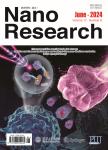Presentation matters: Identity of gold nanocluster capping agent governs intracellular uptake and cell metabolism
Presentation matters: Identity of gold nanocluster capping agent governs intracellular uptake and cell metabolism作者机构:Department of Chemical and Biomolecular Engineering National University of Singapore Singapore 117585 Singapore NUS Graduate School for Integrative Sciences and Engineering National University of Singapore 28 Medical Drive Singapore 117456 Singapore
出 版 物:《Nano Research》 (纳米研究(英文版))
年 卷 期:2014年第7卷第6期
页 面:805-815页
核心收录:
学科分类:0710[理学-生物学] 0808[工学-电气工程] 0809[工学-电子科学与技术(可授工学、理学学位)] 07[理学] 08[工学] 071009[理学-细胞生物学] 09[农学] 0826[工学-兵器科学与技术] 0805[工学-材料科学与工程(可授工学、理学学位)] 0901[农学-作物学] 090102[农学-作物遗传育种] 0702[理学-物理学]
基 金:financial support from the Ministry of Education Academic Research Grants to D.T.L financial support from the Ministry of Education Academic Research Grants to C.Y.T financial support from the Ministry of Education Academic Research Grants to J.P.X the Faculty of Engineering Strategic Research Fund to D.T.L
主 题:nanotechnology nanobiology gold nanoclusters reactive oxygen species surface chemistry
摘 要:Au nanoclusters (AuNCs) hold tremendous potential to be employed in a wide variety of biological applications. Despite the rapid development in the field of NCs synthesis, a comprehensive understanding of how cells interact with this class of ultra-small nanoparticles (〈2 nm) having defined sizes and surface chemistry, remains poorly understood. In this study, we show that the choice of the surface ligand used to protect AuNCs can significantly perturb cellular uptake and intracellular redox signaling. A panel of monodisperse, atomically precise AuNCs with different core Au atom number (i.e., Auls, Au18 and Au25) protected with either mercaptopropionic acid (MPA) or glutathione (GSH) capping agent were synthesized and their effects on the generation of intracellular reactive oxygen species (ROS), cytotoxicity and genotoxicity of the NCs were assessed. Both mitochondrial superoxide anion (O2^-) and cytoplasmic ROS were found to be higher in cells exposed to MPA but not GSH capped AuNCs. The unregulated state of intracellular ROS is correlated to the amount of internalized AuNCs. Interestingly, MPA-AuNCs induction of ROS level did not lead to any detrimental cellular effects such as cell death or DNA damage. Instead, it was observed that the increase in redox status corresponded to higher cellular metabolism and proliferative capacity. Our study illustrates that surface chemistry of AuNCs plays a pivotal role in affecting the biological outcomes and the new insights gained will be useful to form the basis of defining specific design rules to enable rational engineering of ultra-small complex nanostructures for biological applications.



